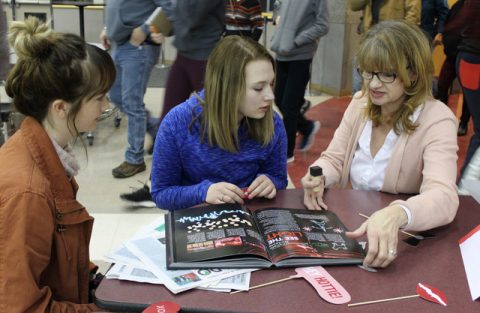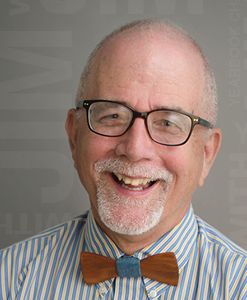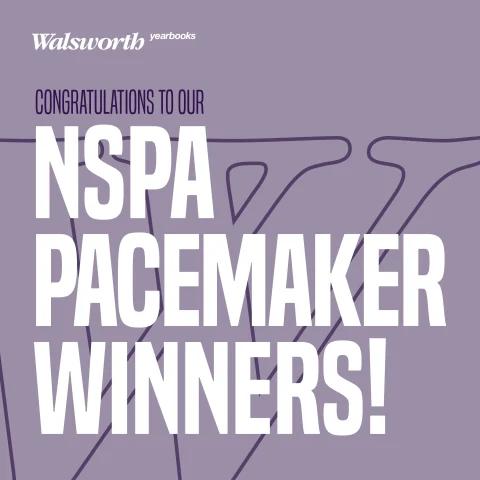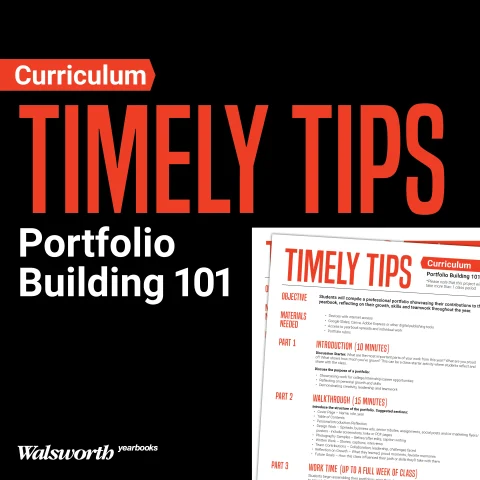When Jai Tanner made the move from El Paso, Texas to the Pacific Northwest a few years ago, it didn’t seem on the surface to be such a daunting change. But the award-winning yearbook adviser soon learned she was in for a bit of culture shock at her new school, and that the regional differences were significant.
It might have taken a little time, but Tanner has now settled in at Yelm High School in Yelm, Washington, and she’s bringing her own brand of creativity and sense of style to the classroom in a way that works.
You can hear Tanner’s story in full detail in the newest episode of the Yearbook Chat with Jim podcast.
Profile
Jai Tanner
Yelm High School, Yelm, Washington
High School Attended: Hart High School, Hart, Texas
College Attended: Texas Tech University, Lubbock, Texas
Did you participate in journalism in high school? What publication and what was your role?
Yes, I did. I was supposed to be editor my senior year, but I flaked out and did theatre instead! I could have done both: I don’t know what was going through my head! I did take journalism classes in college, but ultimately settled on a BA degree in English, with minors in history and art. I also earned my MA in English. I have to say that my degrees have served me well.
Size of Your Book: 9
Number of Pages in Your Book in 2018: 244
Student Population: 1700
Number Sold in 2018: 600
Other Classes You Teach: Photojournalism, Journalism
Number of Books You Have Advised (including the 2019)? Four at Yelm, 21 overall
Other schools you have advised at:
Gadsden High School, Anthony, New Mexico – 4 years
Austin High School, El Paso, Texas – 3 years
Franklin High School, El Paso, Texas – 11 years
Yelm High School, Yelm, Washington – 3 years
Q&A
How did you decide to go into teaching? Advising?
I knew the things that I liked—writing and illustration—and I wanted to find a career that accommodated those. Also, I tend to be a person with a learning mindset, and teaching provided that opportunity. Yearbook happens to combine art, design, writing and photography, so for me, it was a perfect fit.
What was the most difficult part of your first year advising?
It was great! I didn’t know much, but I had been on my high school yearbook staff, and I knew general art principles. I worked with a teacher who was a photographer, and my students were able to create a nice book. I always say that my job in life is to make things look pretty, and we did. I am still quite close to some of those first students. Of course, looking back, we would now write better captions and stories in AP style, but all in all the school population was happy with the product, and so were we.
What made you want to come back for year two?
It was fun! I had good students, and we were a little more experienced, so I did a total of four books at Gadsden. It was more dynamic than just teaching English, which I had done for 10 years prior, and I liked the constant change.
What advice would you give to a first-year adviser?
Find your strength and run with it. In time, you will learn more of the niceties of yearbook-making, but right now, bond with your good students and create a product that will please your audience. Always try to submit a few more pages than the deadline requires.
Over the years, what have you enjoyed most about advising a yearbook?
It’s really two things: (1) creating art with like-minded people (students), and (2) the relationships you build with those students. I still keep up with most of my editors, have attended a wedding or two, and follow their successes in life and in their careers.
What has been the most difficult part of advising for you?
My current move to Washington has been most difficult. Though I had advised for 18 years, I was walking into a new culture and a new environment. One would think if all students are from the U.S., there wouldn’t be that much of a difference, but there can be significant regional differences. I am constantly adapting my curriculum and ways of approaching teaching. I am trying to figure out how to engage students in the long term… how to create that magic that came so naturally in New Mexico and Texas. And I miss the sun! The summers are glorious here, but the winters are long, overcast and rainy. That has a way of affecting everyone’s mood. When it gets dark by 4:30, no one wants to stay late for deadline. There is always work to be done, and too often, too few people who are willing or able to do it. But I must give credit to Meghan Pigmon, the current EIC. She takes her job seriously, and Meghan and I have spent many an afternoon together doing what needs to be done. Her devotion to the book makes all the difference.
You developed an award-winning program in El Paso, Texas and then moved up to Washington. Tell us about some of what your program was like in El Paso.
It was magic! The first two years, of course, were a little rough, but by year three, it began to flow. Alejandra Matos (Wassem), the EIC, was my first major player. She is currently an editor at Hearst Newspapers, and she has worked at The Houston Chronicle and The Washington Post, among other publications. Once the ball started rolling, it didn’t stop, and the program just kept getting better and better. In my last years, with Haewon Ma and Bailey Bridler at the helm, I knew I didn’t have to be there for things to be done well and to be done correctly. The kids taught each other, and they loved each other. We knew it was something special — sometimes very time-consuming — but worth the effort. We met my goal: that the art and the purpose were greater than we were as individuals.
How has it been starting over after you and your previous program had been so successful?
Igor Stravinsky said, “I work a little every day, and it isn’t always gold, or truth, or honesty.”
I try to do this. Accomplish a little every day. Move forward a few steps. Keep trying. Experiment. Do what works. Be realistic. When you are tired, rest. Don’t quit. All is well, and all will be well. (I have to give myself a lot of pep talks, oftentimes on the 35-minute drive through the forest as I go to work.)
My purpose as a teacher has changed. Of course, I want to create a beautiful book with strong content, but my current students have greater needs than my students in New Mexico and Texas. I don’t think economics has everything to do with it. I have taught poor students, but their families were intact. Too many of my current students have unstable lives, and it’s hard to give your all when your life is in turmoil. My current purpose is to try and respond with kindness, to try and help create better human beings. I have seen the treatment of other human beings diminish, and I have seen students who do not know how to communicate with anything that is not electronic. I don’t know if it is regional or generational. But I know that it IS. I still believe that my content area (taking photos and getting interviews) helps connect people in ways that are essential to the human experience. As teachers, as adults, as nurturers, we have to corral the little ones in our culture towards being good humans.
My students at Franklin were global thinkers (and many have lived or traveled out of the country). Of course, many went back and forth between Mexico and the U.S., so international relationships were inevitable. My students at YHS tend to be more regional thinkers. Though some have traveled (like Meghan Pigmon, my current editor), many haven’t been out of the Pacific Northwest. Travel changes the way you think, and the way you see people and the human experience in general.
The artistic vision of the book is different too. At Franklin, the book didn’t have to be school colors or include the school mascot. At YHS, the students want to see red and black every year, and they want to see a tornado. However, I have to draw the line somewhere: we are not having a clip art tornado anywhere in the book! It’s a good thing I like red and black (my college colors at Texas Tech), but it can be a challenge to use these colors every year. In fact, the book that my editors conceived at camp in the summer of 2018 was scrapped. We talked to a lot of people and they said, “It just doesn’t feel like Yelm.” So we went back to the drawing board and came up with YOUR STORY, which uses the big collegiate Y so often seen in Yelm. Part of our job is to create a great book with our aesthetic, but another part is to be realistic about what our audience wants. You have to bridge those two. They are both vital.
One of the best things at YHS is the support from the administration. I also have what I need in terms of equipment. My principal and CTE director are pretty amazing!
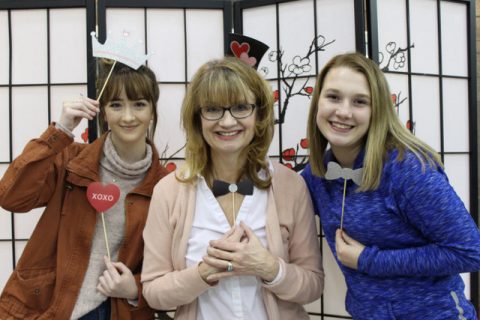
What goals have you set, personally, for your new program?
My resolution for the new year: (1) smile more and (2) take care of business. I’m an artsy person, so I don’t always enjoy dealing with pragmatic issues, like paying bills. But I do. Just get it done, and it’s not so bad. I realize I am not a natural smiler, so I am trying to soften and consciously encourage a smile come through. There just might be someone who needs it, and it actually makes me feel better too.
I am working on getting photography students prepared to take and pass the Basic Photography Precision exam, which can allow them to earn college credit. We are on a test run this year, but I am learning. I just have to break it all down and address the many components.
In terms of yearbook, I am seeking out those students who will stay with the program for a while. Our population tends to be transitory (military and otherwise), so the person who starts out as an editor may not be there the whole year. In fact, I lost Maliya, who was a top editor, when her parents moved to Florida in October. It can be a bit crippling, but you have to figure out how to go on. Find that next special kid and cross your fingers!
What are you proud of in your life as an adviser?
I am proud of ICON, the Franklin High School 2010 yearbook. It was a 20-year anniversary book and it had layers of content: (1) primary content (2) secondary content; and (3) tertiary content in the form of social media. In addition, on the theme pages, it touched on the history of that school, which I loved dearly. But with the help and direction of Alonso Munoz, EIC, that book was both a Gold Crown winner and a Pacemaker winner. There were only five books in the nation to accomplish that feat, and ICON was one of them. It was indeed a proud moment.
I am also proud of HUMAN, the last book I did at Franklin. As my swan song, my goodbye gift to that school, HUMAN was a spinoff on Brandon Stanton’s Humans of New York series. It was a side-bound book, and the content was excellent. It told real stories and it evoked real emotion, and it was beautiful. It won a Gold Crown, too. I had left by the time Pacemaker entries were due, so it never got entered.
There are many books I am proud of — SHIFT was another. It was my first Crown award for yearbook. It was kind of a spinoff of Andy Warhol-inspired art. Shea Houlihan, EIC, was a master writer in that book.
A few quotes that best illustrate my life as adviser:
- To thine own self be true;
- My life is organized chaos;
- Everyone has a story.
Be truthful to yourself, to your aesthetic, with your gifts. Always analyze, question and return to look with fresh eyes. Don’t look to others to compare; look to others for inspiration. Look outside your realm. I have found some of my best inspiration from architects and artists. Be realistic about what you can give. Don’t promise more than you can deliver.
I can’t say that I am organized in general; but I do have a system that’s similar to the random, organic order of the universe. Yes, some things get lost, but with a few prayers to St. Anthony, they often turn up. And if they don’t, do it again. It will probably turn out better. I generally know what things to look for to go in the book—photos, quotes, etc.—and they generally get found. My desk is always messy (many students over the years have tried to organize me, to no avail), but I have a vision for my work. Organized chaos has a flow; give into that and things run easier.
People walk around all the time and never tell their stories. I understand that, to some extent. But sometimes people want to tell their stories, and if they do, I want my staff to honor that. To respect the pain or hope or joy or disappointment. If we can get just a little bit of real HUMAN truth in the book, I am happy. There are stories beyond scoreboards and theatre productions.

